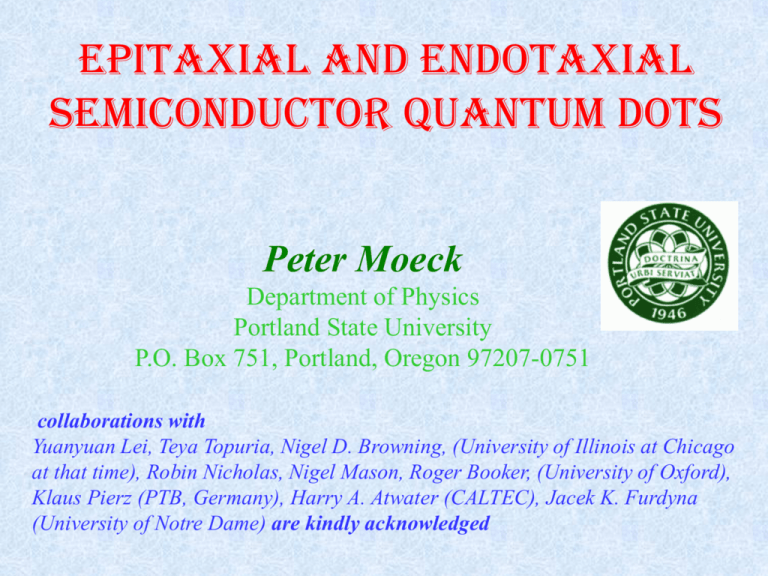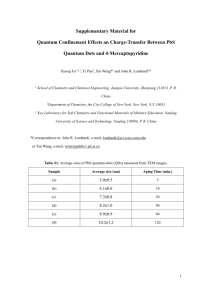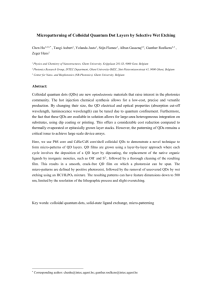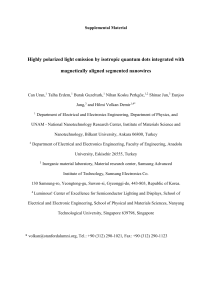Epitaxially grown quantum dots
advertisement

Epitaxial and endotaxial
semiconductor quantum dots
Peter Moeck
Department of Physics
Portland State University
P.O. Box 751, Portland, Oregon 97207-0751
collaborations with
Yuanyuan Lei, Teya Topuria, Nigel D. Browning, (University of Illinois at Chicago
at that time), Robin Nicholas, Nigel Mason, Roger Booker, (University of Oxford),
Klaus Pierz (PTB, Germany), Harry A. Atwater (CALTEC), Jacek K. Furdyna
(University of Notre Dame) are kindly acknowledged
Outline
1. Introduction to quantum dots (QDs)
2. Stranski-Krastanow grown QDs
3. Sn QDs in Si
4. Summary and Conclusions
1. Introduction to quantum dots
What are semiconductor quantum dots (QDs)?
Traps for matter waves, artificial pseudo-atoms, entities with discrete
energy levels
one-dimensional, time independent
Schrödinger’s equation
d 2
8 m 2
[ E U ( x )]
2
2
dx
h
Electron in atom: ΔE = 1-10 eV, L = 0.1 nm
Exciton in semiconductor quantum dot: ΔE ≈ 0.1 eV, L ≈ 10 nm,
QDs should be self-assembled (for economic gains, not quite in reach of nanolithography)
1) semiconductor with smaller bandgap embedded into matrix with large bandgap
2) just right size, large enough to accommodate an exciton, small enough in all directions
for quantum confinement
3) no structural defects such as dislocations
KEY ISSUE: uniformities of size, shape, chemical composition, strain distribution,
crystallographic phase, mutual alignment, …
optoelectronics (no contacting problem, only problem QD array homogeneity)
- active medium in lasers, (In,Ga,Al)As based 1.3
μm!
- far infrared detectors
- novel device concepts such as quantum cellular
automata
Section Outline: Epitaxial QDs
2. Stranski-Krastanow grown quantum dots
2.1. Problems and opportunities
2.2. Thermodynamical argument for structural
transformations
2.3. Implications and experimental support
2. Stranski-Krastanow grow QDs
2.1. Problems and opportunities
deposition, surface diffusion, interdiffusion are random events, →
random alloy quantum dots, cake with raisins
smaller bandgap semiconductor (alloy) usually larger lattice constant
What structure results from this process?
epitaxially grown QDs compressively strained, random distribution of atoms
in adamantine host structures → ordinarily strained QDs
examples (In,Ga)Sb islands/quantum dots on/in GaSb substrate/matrix
100 nm
AFM image, different types of islands,
result in different types of quantum dot
when overgrown
CTEM 220 dark
field close to
[001], plan view,
Ashby-Brown
type Black-White
(BW) contrast if
strained
10 nm
HRTEM, <110> cross
section, Moiré’ fringes
if relaxed,
shape: “convex lenses
with varying degrees of
curvature”
Semiconductor superlattices → smaller bandgaps!
since compound semiconductor alloys are not regular substitutional solid solutions, there
is always some anticlustering and clustering (short range order)
A.H. Cottrell, Theoretical Structural Metallurgy, Edward Arnold Publ., 1954, p. 98
heteroepitaxy: “external strain enthalpy” due to elastic deformation of deposit
calculated (In,Ga)As phase diagrams, bulk or completely
relaxed (left); single layer pseudomorphically
constrained to In0.5Ga0.5As substrate (right)
J.Y. Tsao, Materials Fundamentals
of Molecular Beam Epitaxy, Academic Press, 1994, p. 93-150
similarities to intermetalics, e.g. Al2Cu, Guinier-Preston
zones, understood as aging effects, age hardening,
observed 1906, explained 1938
We know: Epitaxially grown quantum dots:
- are always alloyed
- possess same structural prototype as constituent elements or compounds
- random distribution of atoms in respective sublattices
- usually compressively strained (a few GPa!) – just as endotaxially grown
QDs, “ordinarily strained” QDs
-----------------------------------------------------------------
We also know: semiconductor alloys have propensity to atomic
ordering and phase separation, i.e. formation of crystallographic
or chemical superlattices, which also have the smaller band gaps we desire
Are there structural transformations ?
Can atomically ordered QDs be created at will ?
2.2. Thermodynamic arguments
minimization of Gibbs free energy G = E – T S + p V
(compressively strained) OS-QDs, subscript OS
p V = BOS ΔVOS accurate to within 10 % !
sphalerite → atomically ordered (subscript AO) negligibly strained,
ΔVAO ≈ 0, p ≈ 0
EOS – T SOS + BOS ΔVOS > EAO – T SAO
Tc
EOS E AO BOS VOS
SOS S AO
larger BOS ΔVOS → larger Tc
(neglecting interfaces)
What does enhanced Tc mean?
classical theories (Bragg-Williams, Bethe, Kikuchi) of long and short-range atomic
ordering as cooperative phenomena (also called critical phenomena)
higher Tc, more atomic ordering, shorter thermal treatments at higher
temperatures
-----------------------------------------------------------------------
quenched-in vacancies
nV
FV
exp
N
k T
FV ≈ 1 eV, fast quench from growth temperature (500 ºC) to room temperature
→ up to ten order of magnitude higher vacancy concentration,
in strain gradients, vacancies move to places of higher compressive strain
more quenched in vacancies at OS-QDs, faster atomic ordering !
2.3. Implications and experimental support
ordinarily strained In0.75Ga0.25P QD in Ga0.75In0.25P matrix,
3.6 % compressive strain
EOS – T SOS + BOS ΔVOS > EAO – T SAO
(famatinite)
for T = 300 K, strain evenly distributed
- 0.66 eV/atom + 0.6 eV/atom > - 0.33 eV/atom
hydrostatic pressure (GPa)
→ negligibly strained (atomically ordered) crystallographic superlattice(s)
(without hydrostatic pressure, i.e. lattice mismatch strain → sphalerite
structure)
→ Prediction 1: many different phases may exist
(Zn,Mn)Se matrix
2
3
1
5 nm
a
b
Atomically ordered (Cd,Mn,Zn)Se QDs and agglomerates in (Mn,Zn)Se
matrix,
a) Atomic resolution Z-contrast image. All large agglomerates posses orientation
relationship (020)agglomerate║(2-20)matrix, (110)agglomerate║(1-13)matrix. Although quite
large, free of structural defects, except occasionally antiphase boudnaries, indicating
negligible external lattice mismatch strains
b) Selected area electron diffraction pattern (at least two agglomerates)
Tc
EOS E AO BOS VOS
SOS S AO
Tc ≈ 486 K, if stain evenly distributed between QD and matrix
but, if all external lattice mismatch strain accommodated by
quantum dot alone
Tc ≈ 852 K, i.e. in range of growth T
For this materials system actually observed by U. Håkanson et al., Phys.
Rev. B 66, 235308 (2002), Appl. Phys. Lett. 82, 627 (2003)
Also short range order in (In,Ga)Sb in GaSb matrix right after MOVCD growth
observed by TEM, so it probably originated right after growth
→ Prediction 2: Tc may be in order of magnitude of growth
temperature
a
b
Atomically ordered (In,Ga)Sb quantum dot in GaSb matrix
a) High-resolution TEM, b) Selected area electron diffraction
pattern
Images recorded at 500 C, at which specimen was held for 2 h (and previously
held at 475 C and 350 C for 2 h each), suggesting atomically ordered QD is
structurally stable and Tc is of order of magnitude of growth temperature
→ Prediction 3: long and short range order may arise when
samples are stored at room temperature
a
b
Atomic order in Stranski-Krastanow grown (Cd,Zn)Se quantum
dots in ZnSe matrix
after ≈ 38 month storage at room temperature; high-resolution TEM,
a) Long-range order, b) Short-range order
neither did appear to exist earlier, C.S. Kim et al., Phys. Rev. Lett. 85, 1124 (2000)
Atomically ordered II-VI quantum dots possess their own
photoluminescence (PL) spectra, i.e. could indeed by employed as
QDs, here (Cd,Mn,Zn)Se QDs in (Mn,Zn)Se matrix as shown earlier
in TEM/STEM images, PL excitation spot is 106 larger than TEM
analysis area, so there is lots of atomic ordering, full line: nonresonant excitation over band gap
10 nm
left: Resonant PL excitation is specific to certain structures,
variations in peak heights as a function of excitation power density
strongly suggests that the 2 eV peaks arises from tunneling of
excitons from “zero dimensional entities”, i.e. the about 25 nm
diameter atomically ordered quantum dots shown in right: HRTEM
image from the same (Cd,Mn,Zn)Se QDs in (Mn,Zn)Se sample
Section Outline: Endotaxial QDs
3. Sn quantum dots in Si
3.1. Problems and opportunities
3.2. Void filling and phase separation
3.3. Shape transition with -Sn precipitate size
3.4. β-Sn and its orientation relationship
3.5. Thermodynamics -Sn → β-Sn
3. Sn quantum dots in Si
3.1. Problems and opportunities
bulk α-Sn (grey tin) direct, 0.08 eV, band gap, bulk substitutional SnxSi1-x
solution direct band gap for 0.9 < x < 1
41.8 % bulk unit cell volume mismatch, solid solubility 0.12 %, conventional
molecular beam epitaxy (c-MBE) restricted to ≤ 10 % Sn, ≤ 10 nm
temperature and growth rate modulated MBE
(tm-MBE), as pioneered at CALTECH:
SnxSi1-x/Si quantum well structures, x = 0.02 to 0.1, 1 - 2 nm,
annealed endotaxial growth of quantum dots, Sn
content raises significantly
tm-MBE at CALTECH:
100 nm Si 550 ºC, 0.05 nm s-1
4-6 nm Si ≈ 140 – 170 ºC, 0.01 – 0.03
nm s-1
1-2 nm SnxSi1-x x = 0.02 - 0.1
≈ 140 – 170 ºC, 0.02 nm s-1
100 nm Si 550 ºC, 0.05 nm s-1
4-6 nm Si, ≈ 140 – 170 ºC, 0.01 –
0.03 nm s-1
1-2 nm SnxSi1-x x = 0.02 - 0.1
≈ 140 – 170 ºC, 0.02 nm s-1
For multi-quantum well structures there
are in situ anneals at 550 ºC for 30 min for
each quantum well
Low growth temperature results in many
vacencies, thermal cycling results also in
vacencies, vacencies condense into
equlibrium shape and size voids
--------------------
Si buffer layer 550 ºC
(001) Si substrate, 550 ºC
K.S. Min and H.A. Atwater, Appl. Phys. Lett. 72 (1998) 1884
SnxSi1-x/Si (multi-)quantum well
structures additional ex situ
anneals 550 - 900 ºC, 30 minutes,
the crucial endotaxy process that
lead to high Sn contents
3.2. Void filling and phase separation
100 nm
left: increase of QD size with ex-situ annealing time, nonlinearities
due to diffusion shortcuts (dislocations, …)
middle: CTEM overview, note QDs within the Si spacer layers
right: HRTEM, perfectly pseudomorph growth, so there must be
other diffusion shortcuts
50 nm
2 nm
Z-contrast STEM images of Sn0.1Si0.9/Si multi-quantum
wells left: Sn precipitates inside the spacer/capping layers
right: void that is at its interface with Si matrix lined by Sn
calculated
“empty” void
experiment
calculated
“fully Sn filled”
void
experiment
left: tetrakaidecahedron with shape parameter A = t / a, equilibrium
shape of voids - also shape of prospective -Sn precipitates, consistent
with Neumann’s symmetry principle, anisotropy of interface energy density
right: quantitative EELS, calculations for “empty” and “fully Sn
filled” voids superimposed
5 nm
5 nm
left: [110] cross section, voids partially filled with Sn
right: same voids significantly more filled with Sn as result
of in-situ anneal at 300 ºC for 3 hours (under the microscope)
[001]
[001]
[010]
5 nm
[100]
[110] cross section, early stage of phase separation
mechanism
phase separation seem to start with formation of {111} Sn-Si interfaces
and preferential substitutional Sn-Si replacements in areas around
intersecting {111} planes
3.3. Shape transition with -Sn precipitate size
5 nm
25 nm
left: from tetrakaidecahedron, as dominated by the anisotropy of
interface energy density (Neumann’s principle), to right: essentially an
octahedron, as possibly dominated by anisotropy of the elastic
mismatch energy – volume (elastic lattice mismatch energy)
increases faster than surface (interface energy)
3.4. β-Sn and its orientation relationship
002Si & 011Sn
111Si
200Sn
111Si
100Sn
100Sn
111Si
200Sn
2 nm
111Si
002Si & 011Sn
[011]Sn projection
left: bright field STEM, right: power spectrum, strain minimizing
orientation relationship (011)β-Sn║(002)Si, (600)β-Sn║(440)Si, and
[077]β-Sn║[660]Si
assuming Si and β-Sn lattice constants: 2.8 %, 1.2 %, 0.9 %
linear mismatch, nothing like the 19.5 % -Sn would have !
shape rhombic dipyramidal polyhedron, Neumann’s principle:
4 2
2
2
3 11 11
m m
m
m
3.5. Thermodynamics -Sn β-Sn
Comparing Gibbs free energies: G = E – TS + pV
pV = Bα-Sn Vα-Sn, ≈ 9.6 keV for 10 nm diameter model QD, 21739 atoms,
0.44 eV per atom, 18.6 GPa, (Sn0.5Si0.5, 0.27 eV per atom, 12.1 GPa)
Eβ-Sn – T Sβ-Sn + Bβ-Sn ΔVβ-Sn + Iβ-Sn/Si + Iinc
< Eα-Sn – T Sα-Sn + Bα-Sn ΔVα-Sn + Iα-Sn/Si
bulk α-Sn β-Sn, 286 K, E – TS will be about same for both phases at
room temperature
homogenous contributions to interface energies (ISn/Si) also about equal
due to mismatch strain minimizing orientation relationships
Bβ-Sn ΔVβ-Sn ≈ 0
incoherent contribution to interface energy β-Sn/Si:
Iinc ≈ 0.1 keV (from dislocation theory)
Eβ-Sn – T Sβ-Sn + Bβ-Sn ΔVβ-Sn + Iβ-Sn/Si + Iinc
< Eα-Sn – T Sα-Sn + Bα-Sn ΔVα-Sn + Iα-Sn/Si
reduces to 0.1 keV < 9.6 keV,
structural transition to β-Sn type energetically favorable!
kinetics may be slow but TEM several years after growth show
both - and β-Sn precipitates
(also β-Sn 26 % higher density than α-Sn)
4. Summary and Conclusions
- atomic order does definitively exist in III-V and II-VI QD structures,
- this reduces band gap, understanding and controlling is needed, such AO-QDs
possess their own PL, have smaller band gaps, and are structurally more stable
than ordinarily strained (random alloy) QDs, better quantum dots
- void mediated formation mechanism for α-Sn QDs may allow growth of
exotic quantum dots, e.g. (In,Si,As) in Si by endotaxy, N.D. Zakharov et al. Appl. Phys. Lett.
76, 2677 (2000)
- structural transformation α-Sn into β-Sn, may render devices useless over time
-------------------------------------------------------------------------------
emerges as a research topic in its own right
- TEM/STEM and complementary structural methods (such as synchrotron
based GI-XRD) as well as spectroscopic method (such as PL) are to be
combined
- structural and spectroscopic analyses are to be combined with (in situ and
ex situ) heat treatments of specimen








